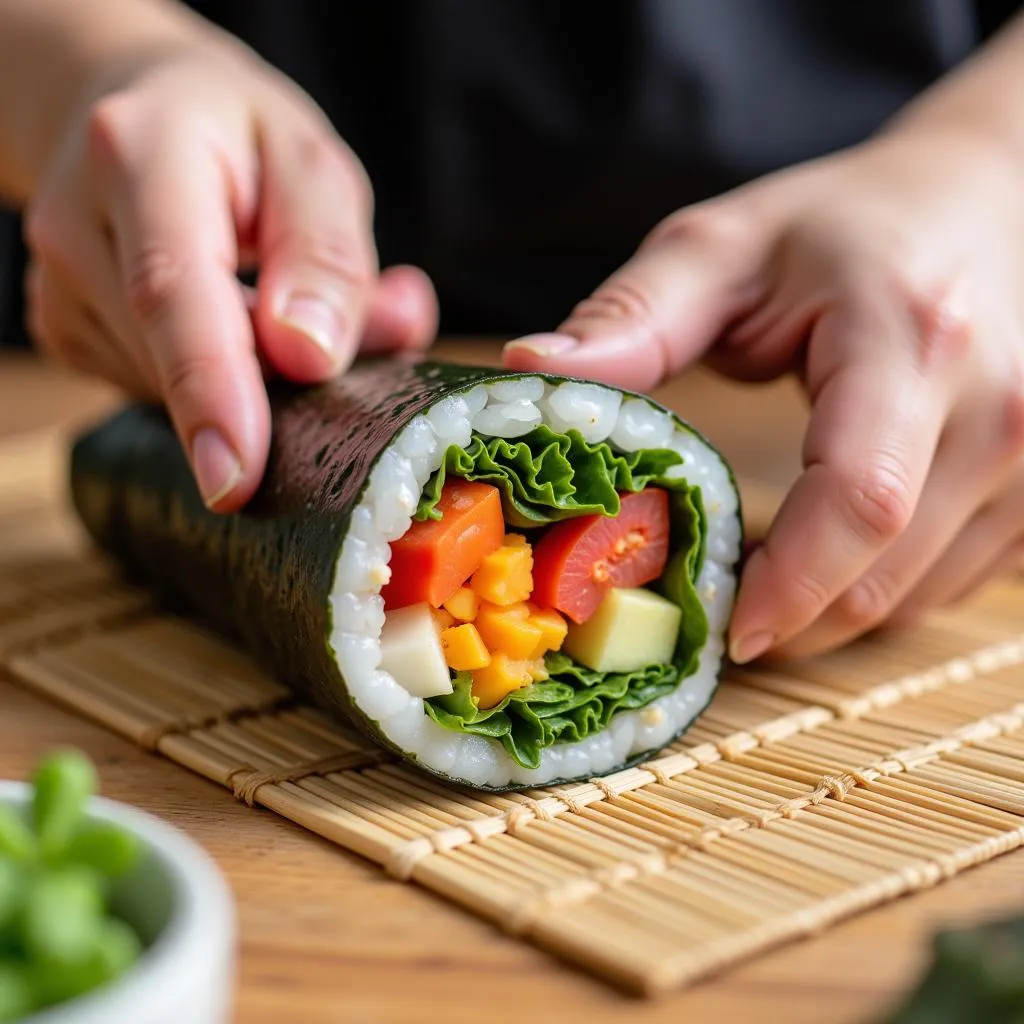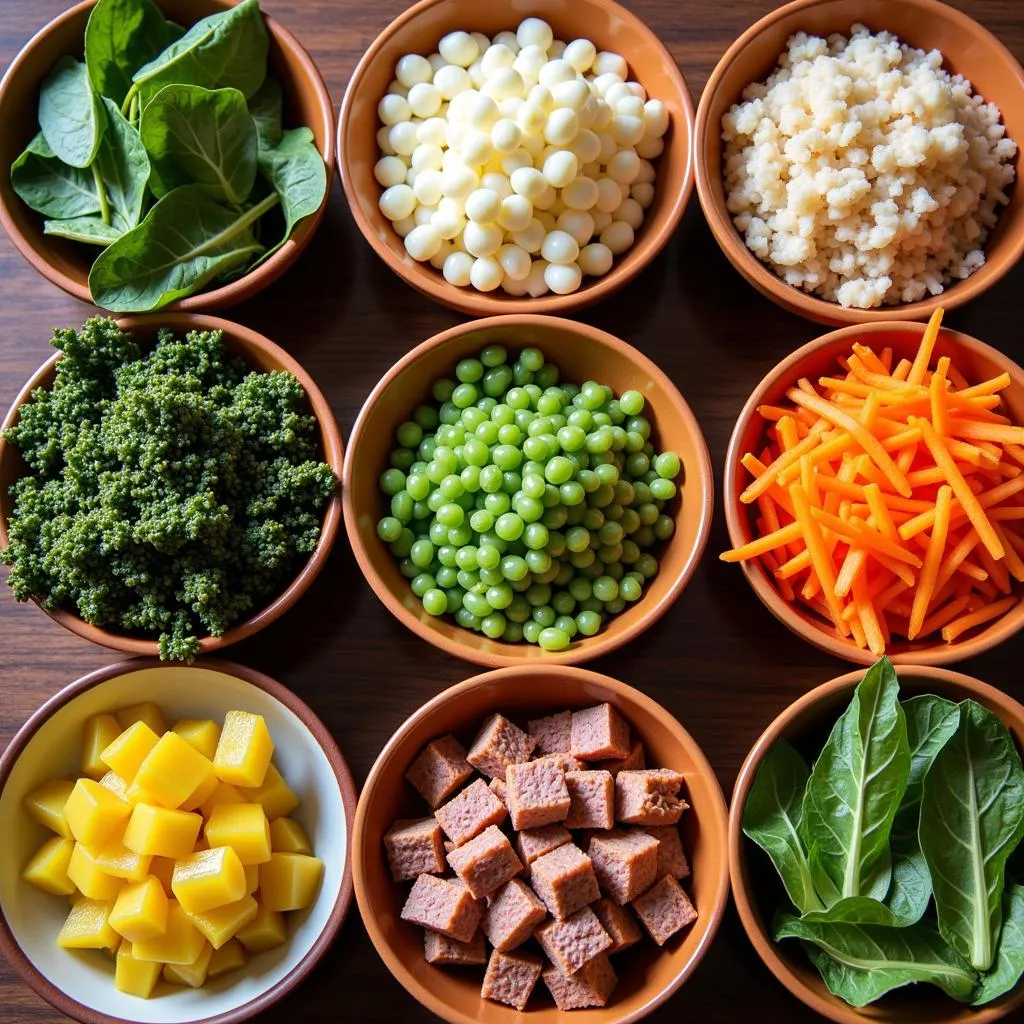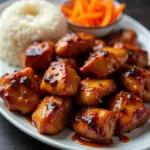Have you ever stumbled upon a dish that looks as beautiful as it tastes? That’s kimbap, the vibrant and versatile Korean seaweed rice roll. Imagine this: you’re strolling through the bustling streets of Hanoi’s Old Quarter, the aroma of street food filling the air. Suddenly, you spot a colorful array of kimbap, each roll a work of art. Intrigued? Let’s dive into the world of kimbap and learn how to make this beloved Korean treat right in your own kitchen!
What is Kimbap?
Kimbap, often called Korean sushi, is a popular Korean dish made with cooked rice, various fillings, and dried seaweed sheets (gim). It’s a delightful combination of textures and flavors, offering a symphony of savory, tangy, and spicy notes in every bite. Unlike sushi, kimbap traditionally doesn’t use raw fish and is seasoned with sesame oil, giving it a unique and addictive taste.
A Brief History of Kimbap
While the exact origins of kimbap are debated, some believe it evolved from the Japanese norimaki during the Japanese occupation of Korea in the early 20th century. However, many argue that kimbap predates this period, drawing parallels to earlier Korean dishes like bokssam, where meat and rice were wrapped in leaves.
 Making Kimbap at Home
Making Kimbap at Home
Making Kimbap: A Step-by-Step Guide
Making kimbap is surprisingly easy and fun. Here’s what you’ll need:
Ingredients:
- Sushi rice
- Dried seaweed sheets (gim)
- Sesame oil
- Sesame seeds
- Salt
- Sugar
- Your choice of fillings:
- Vegetables: carrots, spinach, cucumber, pickled radish
- Protein: bulgogi (marinated beef), tuna, Spam, eggs
- Other: kimchi, fish cakes, imitation crab meat
Instructions:
- Prepare the Rice: Cook sushi rice according to package instructions. Once cooked, mix it gently with sesame oil, salt, and sugar.
- Prep the Fillings: Wash and cut your chosen fillings into thin strips. Cook the protein and vegetables if desired.
- Assemble the Kimbap: Place a sheet of seaweed on a bamboo rolling mat (or a piece of plastic wrap). Spread a thin layer of rice evenly over the seaweed, leaving a small border at the top.
- Add the Fillings: Arrange your chosen fillings in a row across the center of the rice.
- Roll the Kimbap: Use the bamboo mat to tightly roll the kimbap, starting from the bottom and tucking in the fillings as you go.
- Seal the Kimbap: Moisten the top edge of the seaweed with a bit of water to seal the roll.
- Slice and Serve: Using a sharp knife, slice the kimbap into bite-sized pieces. Sprinkle with sesame seeds and serve immediately with your favorite dipping sauce.
Tips for Kimbap Success:
- Don’t overstuff your kimbap, or it will be difficult to roll.
- Use a sharp knife dipped in water to prevent the rice from sticking while slicing.
- Get creative with your fillings! There are endless possibilities when it comes to kimbap.
Variations on Kimbap
Just like the bustling food scene in Hanoi, kimbap offers a world of possibilities. Here are some popular variations:
- Chungmu Kimbap: This smaller, thinner version is often filled with only rice and sesame seeds.
- Triangle Kimbap: This fun and portable version is perfect for picnics.
- Kimchi Kimbap: This spicy and tangy version is for those who like a kick.
 Variety of Kimbap Fillings
Variety of Kimbap Fillings
Kimbap: More Than Just a Snack
In Korean culture, kimbap is more than just a tasty treat. It’s often shared during picnics, outings, and special occasions. Professor Nguyen Thi Lan, a renowned expert on Korean cuisine, notes in her book “Flavors of Korea” that “Kimbap represents the Korean spirit of togetherness and sharing, where each ingredient contributes to the harmony of the whole.”
Exploring Hanoi’s Culinary Delights with TRAVELCAR
While you can easily recreate the magic of kimbap in your kitchen, exploring the culinary landscape of Hanoi offers its own unique charm. From the bustling food stalls of Hoan Kiem District to the hidden gems tucked away in the alleys of Ba Dinh District, Hanoi is a food lover’s paradise. And what better way to navigate this culinary adventure than with TRAVELCAR?
TRAVELCAR offers a range of transportation services, including 16-seater, 29-seater, and 45-seater vehicle rentals, airport transfers, and customized tours. Let our experienced drivers navigate the bustling streets of Hanoi while you focus on savoring every bite of your journey. Contact us today at 0372960696, email us at [email protected], or visit our office at 260 Cau Giay, Hanoi.
So, next time you’re craving a taste of Korea in Hanoi, remember this guide and whip up a batch of delicious kimbap. You might be surprised at how this simple dish can transport you to the heart of Korean cuisine. Happy cooking!

